Editor’s Note: This article is from WeChat WeChat official account "Whale Merchant" (ID:bizwhale), by Wang Xiaoxuan, published by 36Kr with authorization.

Not long ago, the brand of cutting-edge consumer goods announced that it had completed the C++ round of financing within three years, with an amount exceeding 100 million yuan. This company, established in 2018, took only two years with sales exceeding 1 billion.
In recent years, the self-heating hot pot tide spawned by the "one-person food" single economy has caused brands such as Haidilao, Xiaolongkan and Kaixiaozao to flood in. After instant noodles, self-heating hot pot has been promoted to "a must-have for hoarding goods".
When the self-heating hot pot has become a "good heart" for young people and migrant workers, the instant food industry is also welcoming the category explosion, but the self-heating "evergreen style" seems to be turning into a "problem style", and the problems of safety and environmental protection have not only become the shortcomings of the brand, but also restricted the development of the industry.
The road to breaking the game is imminent.
Self-heating hot pot started in Wechat business in 2015. After nearly five years of development, it has gradually developed from online celebrity food to a popular self-heating fast food. From 2015 to 2019, the scale of China’s self-heating hot pot market rose from 233 million to 5.5 billion, and it is estimated that the market scale will reach 7 billion in 2020.
In fact, the technical barrier of self-heating chafing dish is not high, and its principle is the "heating method" in middle school chemistry textbooks. The aluminum powder, activated carbon, sodium bicarbonate and other substances in the heating bag react with the primary battery, which will release a lot of heat and sometimes release flammable gases such as hydrogen.
This food heating technology first appeared in the 1960s. At that time, in Belgium and the Netherlands, people had begun to use quicklime and water as a heating agent to heat mashed potatoes.
In the United States in the 1970s, it was inevitable that the army could not use naked fire to cook food because of bad weather or special strategic needs when performing tasks in the wild. In this case, more convenient self-heating technology came in handy. As military supplies, this is also the first industrial application of food self-heating technology, which was called "hot food of field rations" at that time.
The category of self-heating hot pot should start from 2015. At that time, the self-heating hot pot industry in China rose quietly, and only a few self-heating hot pot brands sold self-heating hot pot products through Wechat business channels, so the market popularity was low and the scale was difficult to expand.
Wechat business’s brand voice is low, the market cultivation degree is low, and it does not have its own production ability, the product quality control is not strict enough, and the user’s mind of self-heating hot pot has not yet been established. Only a small number of consumers know the existence of self-heating hot pot, which leads to the small market demand of self-heating hot pot and the inability to expand production.
From 2017 to 2018, at the moment when the brand of Wechat business was just emerging, many offline chain hot pot brands joined the track one after another, including Haidilao, Xiaolongkan, Dezhuang and Kaixiaozao. They have independent production, processing capacity, restaurant channels, control the taste and taste of hot pot ingredients, and have a natural customer base.
Taking Haidilao as an example, the launch of self-heating hot pot this time is another attempt of the brand in take-out. Before, the take-out of this kind of hot pot brand was always expensive, and it didn’t keep fresh and keep warm. Compared with hot pot take-out, self-heating hot pot has improved in presentation, product heating and heat preservation, and it has become a new product popular with consumers for a time.
Subsequently, they seized the opportunity to promote it through celebrity endorsements, pre-screening advertisements in cinemas and TV drama advertisements. At the same time, they settled in online channels such as Tmall, Taobao and JD.COM, and offline store channels such as convenience stores and supermarkets to further expand their customer base.
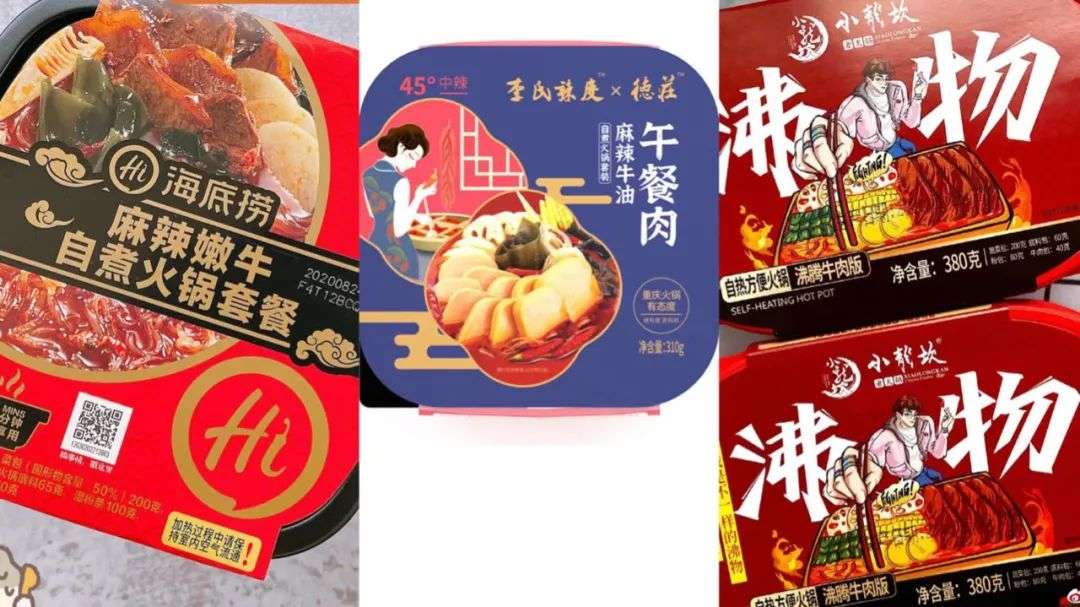
From left to right, there are Haidilao self-heating hot pot, Dezhuang self-heating hot pot and Xiaolongkan self-heating hot pot.
Zeng Yongxiong, vice president of Dezhuang Group, once recalled the madness of his peers. "At the Chongqing Hot Pot Festival in November 2017, I saw that almost all the participating hot pot brands launched self-heating hot pots."
However, these chain hot pot brands do not have the experience of making fast-moving consumer goods, and their ability to promote products and develop channels is not good. After 2018, the orders of many bottom factories, vegetable yards and meat factories fell rapidly, and small brands were eliminated one after another, which gave the opportunity of "latecomers".
Major food brands follow the trend. In 2017, Mo Xiaoxian took the lead on the stage of self-heating hot pot, and the price was 10-20 yuan, which was half cheaper than Haidilao’s 36.9 yuan, taking the route of small profits but quick turnover.
Coincidentally, Cai Hongliang, the founder of Baicaowei, made a comeback in the following year, and entered the self-heating hot pot camp to create a brand "self-hi pot", with prices ranging from 10 yuan to 30 yuan. On the day of "double 11" in 2018, the sales volume of self-heating chafing dish in the whole network exceeded 4.5 million copies, which was more than doubled year-on-year. Since then, the self-heating chafing dish industry has entered a stage of rapid development.
According to the third-party data, in June 2020, the market share of Haidilao and Zihaiguo reached 13.12% and 11.27% respectively, except Mo Xiaoxian, which reached 9.83%, all other brands were around 5% or below.
Among them, the development of self-shabu-shabu is particularly rapid. In 2018, the flagship store of self-shabu-shabu Tmall was launched, and the sales volume of single products became the first in 24 hours, reaching 100 million in the third quarter. In 2019, the overall marketing volume exceeded 500 million, and the turnover in the first half of 2020 exceeded 600 million.
Behind these beautiful figures, it is the credit of self-defeating marketing.
At first, Kenny Lin was invited to promote the advantages of the product with sufficient weight and good taste on social platforms such as Weibo and live broadcast, and humorous product advertisements were filmed for the promotion. A large number of stars filmed videos of eating the pot, attracting a large number of consumers to imitate and buy the hot pot products.
After the red-hot pot was ushered in, it quickly spent hundreds of millions of yuan to put creative pre-screening advertisements in major cinemas, such as Wanda, Dadi, China Film and other well-known cinemas, to stimulate consumers’ desire to buy through advertising videos, and to drive the sales growth of the pot products.
Open a small stove similar to a self-contained pot, boarded Tmall in December 2019, and became the 618 category TOP 1 in half a year; During the period of double 11 in 2020, more than 130,000 sets of products launched by the brand were all sold out in one minute, and the brand also won the TOP1 category of self-heating rice in double 11. Later, Sean Xiao, a popular star, was invited to be the spokesperson for Kaixiaozao, who was well versed in fan economy, to highlight the brand personality and youthful image.
Film and television dramas are also one of the ways to promote the brand of self-heating hot pot. In the TV series "School of Youth", the protagonist Lin Miaomiao has been allowed to enjoy eating self-cooking pots many times. With the rapid popularity of film and television dramas such as "School of Youth" and "Eye of the Storm", a large number of consumers began to buy self-cooking pots to taste.
After a set of marketing combination boxing, Zigui Pot enhanced the brand awareness, and the sales volume rose sharply. It won the first place in the same category of Tmall JD.COM on the day of "618" in 2018, the first place in the same category of "Double Eleven" in 2018, and the TOP1 brand of MAT2020 instant food sales.
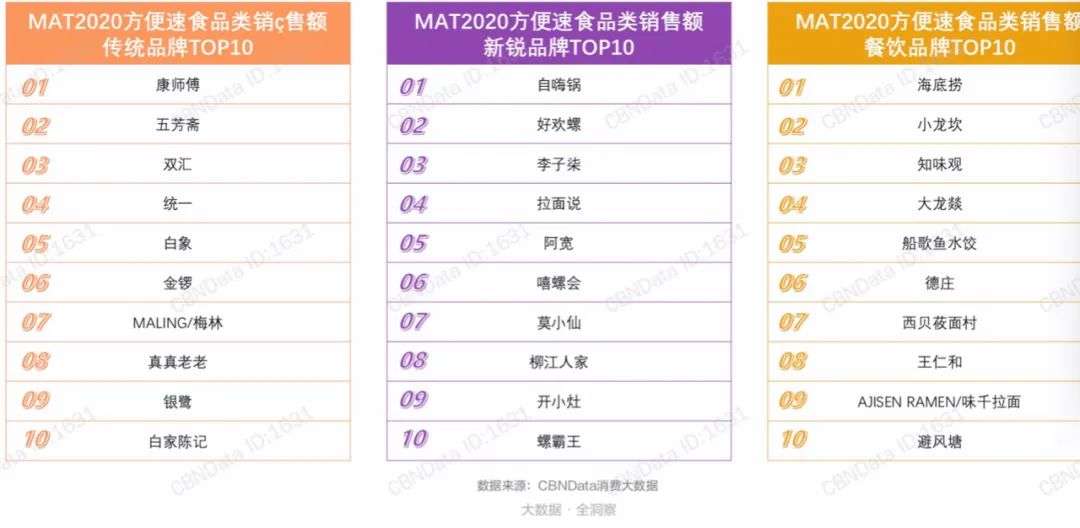
Excerpted from CBNData《2021 Insight Report on Instant Food Industry "
Mo Xiaoxian, one of the competing products of the pot, is also based on TV dramas and variety shows, and at the same time, new media such as live broadcasts and short videos are arranged. The brand also sponsored Mango TV "Daughters’ Love 2" and implanted the brand in 10 TV series. In terms of new media, Mo Xiaoxian cooperated with KOL on mainstream social media such as Weibo, Tik Tok, Aauto Quicker, bilibili, Today’s Headline, Xiaohongshu, WeChat WeChat official account, etc., and shared grass in matrix.
Among these brands, Mo Xiaoxian and Xiao Zao are all online and offline, and only the early self-cooking pot is a pure online brand, grasping the in-station traffic of mainstream e-commerce channels such as Tmall and JD.COM. After November 2018, it was only after the shabu-shabu that it entered the offline channel, and 80% of the cities distributed goods online, seeking the second growth pole.
In fact, offline channels have also brought considerable achievements to the pot. It is reported that in 2019, the overall sales of self-cooking pots, which were only established for two years, exceeded 500 million yuan, of which 70% came from offline dealers. Recently, the new brand "Xiaoqi Kitchen", which is a high-profile brand, mainly consists of various condiments such as stir-fry sauce and bibimbap sauce, and obviously needs to expand the category boundary.
In October, 2020, Zigui Pot began to set up an offline store named "Zigui Pot Hot Pot Clay Pot Rice" in Hangzhou, Shanghai and other places, mainly engaged in clay pot rice with ingredients from Zigui Pot. There are more than 30 kinds of dishes in the store, and the per capita consumption is around 30 yuan. This attempt to enter the offline store from the pot is not only to enhance the brand communication, but also to try to find new performance explosion points.
In terms of categories, the older the players of self-heating hot pot, and the capital support, the brand realizes that "hot pot" is not daily enough, and category innovation is needed to cater to the taste buds of different consumers and the needs of different consumption scenarios.
Self-cooking pot opens a mesh matrix product innovation, expanding many categories such as clay pot rice, bento, vermicelli, zongzi, and hundreds of SKUs, covering self-heating, brewing, quick cooking, ready-to-eat and other ways of use. Among them, "self-heated rice" has become the "new standard" for young people.
Its brand has also launched a series of sub-brands of self-heating snail powder and boiled noodles-"Picture", in which "Picture" can be eaten after boiled in cold water. The products include Chinese bagged noodles, Chinese boxed noodles, Chinese barreled noodles and Japanese barreled noodles.
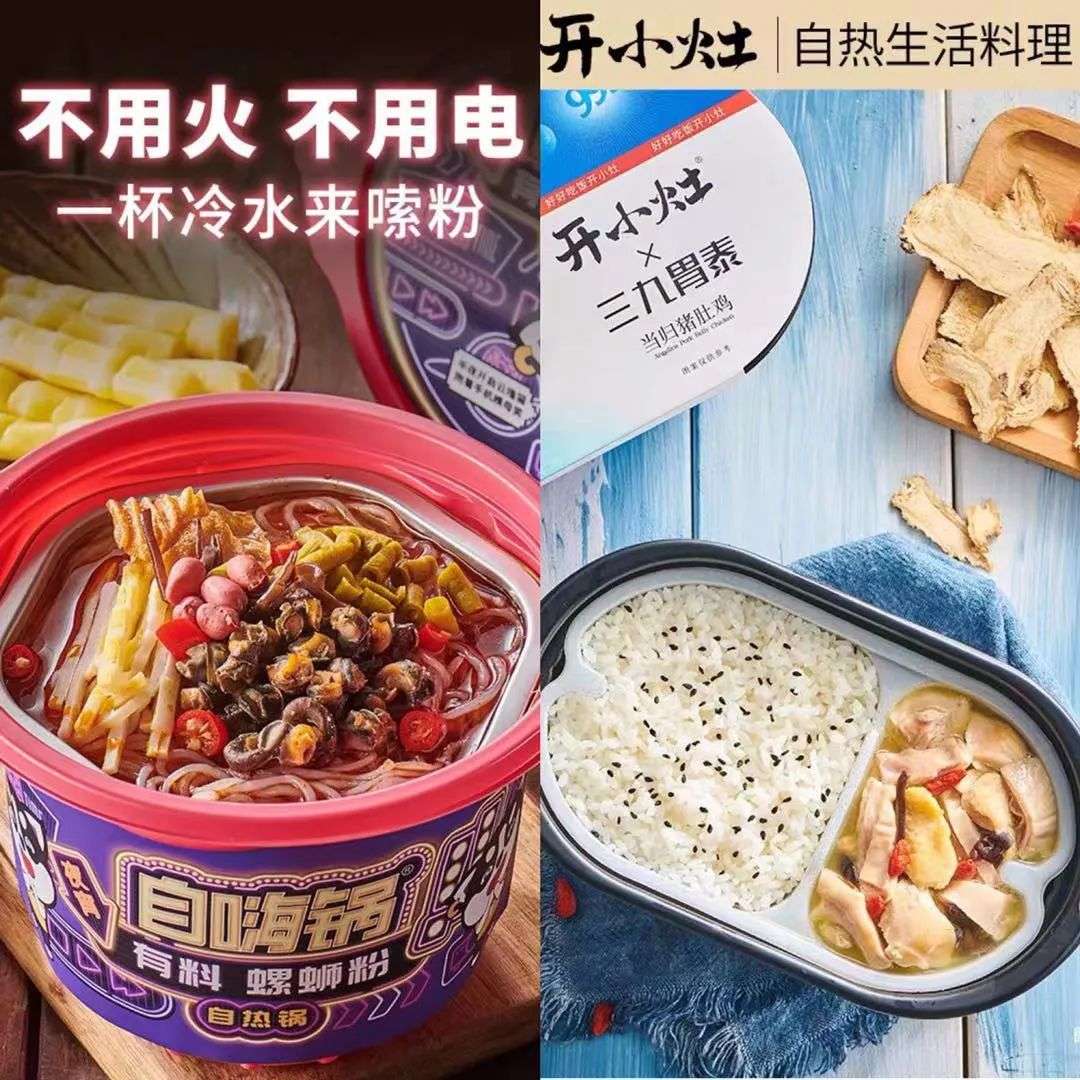
Kaixiaozao and Sanjiu Weitai jointly launched the "Angelica Pork Belly Chicken" self-heating rice, which made the self-heating products that consumers always thought were "unhealthy" look healthier. Some consumers even added raw eggs, vegetables and other ingredients to the self-heating rice, which not only ensured nutrition, but also enhanced the fun of "cooking".
These "routines" make the self-heating hot pot brand quickly start to become a leader in the industry. However, the accompanying security questions have never stopped, and even become more obvious.
On the black cat complaint platform, there are 141 complaints about the self-help cooker and 30 complaints about Mo Xiaoxian. More than 40 complaints are about the self-help cooker eating foreign bodies such as hair, sand and insects. There are also many complaints about damaged heating packages and false propaganda.
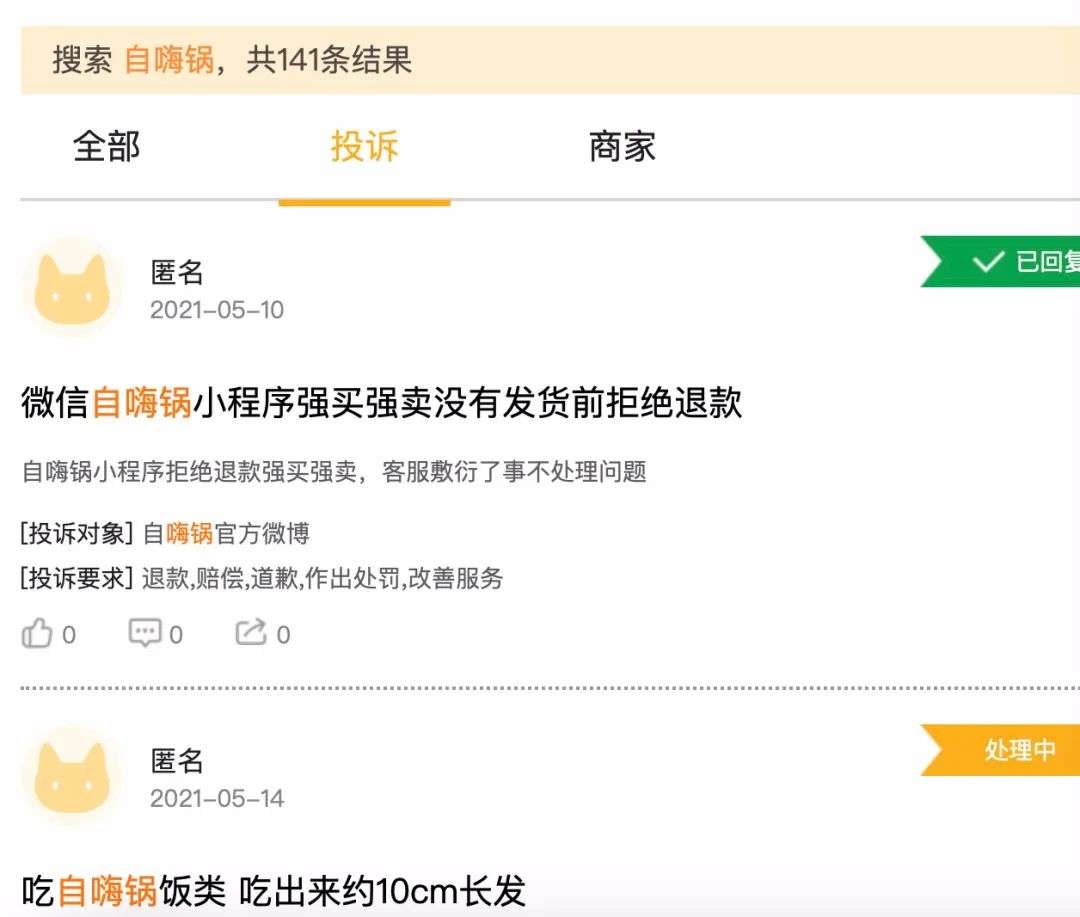
It can be seen that the problem of unclean ingredients in self-heating hot pot is not uncommon. Its dishes are similar to hot pot, with lunch meat, vermicelli, lotus root, fish balls and other foods as the main ingredients, and basically do not use green vegetables that can not be preserved. However, this kind of nutrition is not balanced, and high salt, oil and fat have become the labels of self-heating hot pot, and its oil and salt content generally exceeds the recommended intake of China Nutrition Society.
According to Zhu Danpeng, a food industry analyst in China, the rapid development of self-heating food driven by the epidemic situation is a phased dividend. In the future, with the gradual deepening of the "home economy", there will be a certain market for this kind of food. However, at present, the self-heating food industry still lacks relevant national standards, and food enterprises need to ensure good quality. This kind of online celebrity products have a long way to go if they want to stay popular.
The State Council has also issued a number of convenience food-related policies in terms of food safety and technological upgrading, in order to facilitate a healthy competitive environment in the food industry, unify industry standards and accelerate the steady development of the industry.
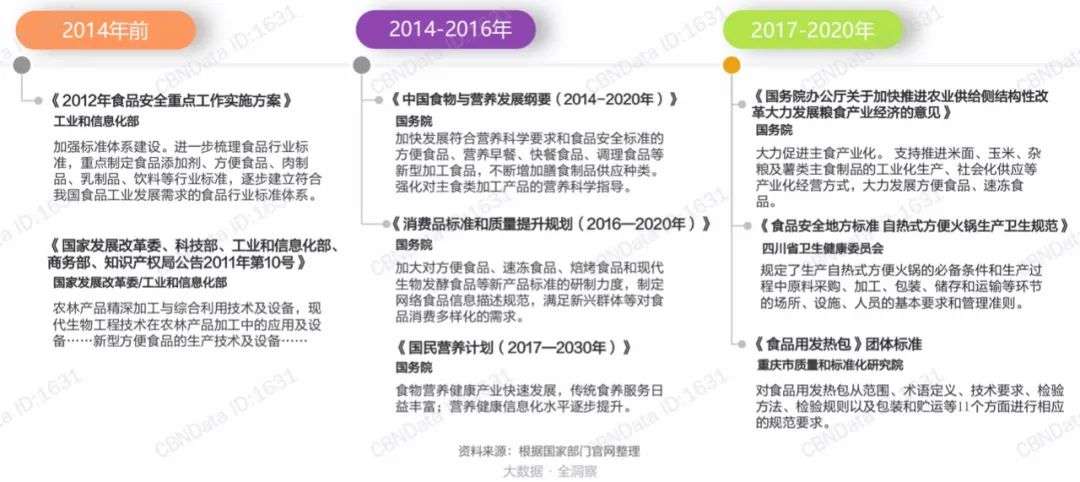
Excerpted from CBNData《2021 Insight Report on Instant Food Industry "
In addition to the safety and hygiene of ingredients, consumers are more concerned about the safety problems in the heating process, such as whether the lime bag will explode, burn and endanger personal safety. This concern is not out of nothing, and similar adverse safety incidents have occurred many times, and consumer complaints are also increasing.
Although the package of self-heating hot pot is written in bold red letters "No eating, no hot water and no naked flame", there are still many safety problems of self-heating hot pot every year.
Firefighters conducted an experiment on National Fire Safety Day in 2020. You can see four security risks.
First, if the steam port of the self-heating hot pot is blocked, an explosion may occur. In fact, even if the steam port is not blocked, because it is heated to a high temperature in a short time, the steam released will be sprayed on people, which may also lead to burns.
Second, the sudden warming of the lower surface of the self-heating hot pot will lead to the sudden warming of the placed desktop. If the table top material is not malleable (such as ceramics or glass), local overheating may lead to cracking. And if the desktop is not heat-resistant, it may be burnt-although it does not cause harm, it is not worth damaging the furniture.
Third, the contents of the heating bag itself are dangerous goods. Calcium lime in a self-heating bag can be regarded as "inflammable and explosive dangerous goods" with iron powder and aluminum powder.
Fourth, we should also consider the environmental impact. After the hot pot is heated, quicklime becomes hydrated lime, which is very corrosive. Throwing a considerable amount of hydrated lime into the environment will have a great impact on the disposal site. In food production, the waste with high acidity and alkalinity cannot be directly discarded or discharged, while the garbage from self-heating chafing dish can be regarded as "harmful waste".
As the head brand of self-heating food industry, self-cooking pot began to build automation technology factories in order to change the above situation, and 10 factories were built in three months, totaling 450,000 square meters.
Self-cooking pot and Chongqing Institute of Quality and Standardization also participated in drafting the group standards of Self-heating Instant Food and Heating Package for Food, which led the self-heating food industry to a higher standard with self-discipline.
In order to reduce costs and improve production efficiency, Zihiguo has built a 30,000-square-meter taste center in Chongqing, and built intelligent factories in Henan, Jiangsu and other 10 places, adding automatic assembly lines, which greatly increased production capacity and released two-thirds of the labor force. Make products more attractive in price by saving costs.
In terms of packaging, Zigui Pot gradually gave up plastic packaging, and invested a lot of human and financial resources to develop and more environmentally friendly packaging products. In the past, the commonly used red and black plastic packaging boxes have been changed from self-cooking pots to more environmentally friendly ones, and the sugarcane paper outer boxes made of national environmental protection materials can be directly degraded, which is more environmentally friendly and safe. The silvery-looking self-cooking lunch box can also be waterproof and oil-proof, and can also be cooked at high temperature, making it more convenient to use.
Nowadays, more and more brands have joined in the battlefield of self-heating food, and the head player such as self-cooking pot can only make haste to avoid frequent hidden dangers such as food safety, so as to continue to "hey" on this road.